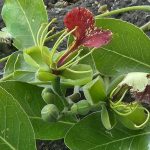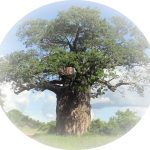TREE LIFE 533
JANUARY 2025
PLANNED EVENTS: JANUARY
Since inclement weather or other issues may vary our plans, WhatsApp Tony Alegria on 0772 438 697 to join our WhatsApp group for last minute updates.
Saturday 4TH January 2025: visit to the National Botanic Gardens. Meet at 8.30 in the main car park and join us for a morning looking at trees that catch our interest.
Main meeting January 2025: This has not yet been finalised but we expect to meet on Sunday 19th January (the 3rd Sunday of the month) so please check your WhatsApp for details (including “weather” the outing has been finalised due to rainy conditions!)
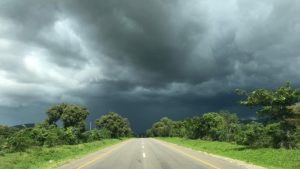
Acknowledgement: The Zimbabwe Mail, 30 December 2024
REPORTS FROM PREVIOUS OUTINGS
SATURDAY 7TH DECEMBER 2024: NATIONAL BOTANIC GARDEN OUTING
RARE FOREST TREES
By Linda and Mark Hyde, additional photos – Jim Dryburgh & Flora of Zimbabwe
Despite competing events for Tree Planting Day, including one run by MyTrees at Art Farm, seven members of the Society gathered at the Botanic Gardens, namely Jim Dryburgh, Dido de Swaart, Linda Hyde, Anne Sinclair, Charles Crawshaw and Jan van Bel, led by Mark Hyde.
Tony was busy elsewhere and so Mark took over to lead the walk. He had recently been shown by Jonathan Francis a flowering specimen of Rinorea convallarioides in the Garden. This is a rare forest species in Zimbabwe and so Mark decided to have a look at this plant and also some other rare forest species grown in the Botanic Garden. As typically happens, we were side-tracked by a number of other interesting observations on our way, and these are mentioned later.
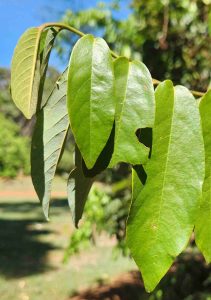
Monanthotaxis sp
The following are some notes made by Linda on the walk to which have been added comments from Mark.
The first species of note was an unnamed species of Monanthotaxis. It is a rare forest climber with drooping leaves which are green above and blueish beneath. We await flowers and fruit in order to identify it specifically.
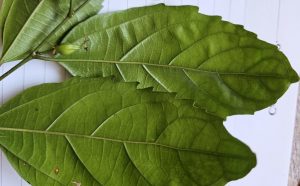
Celtis mildbraedii
A new location in the Gardens was found for Celtis mildbraedii, the Red-fruited White-stinkwood. This has leaves that are large and may be dramatically toothed. The picture shows a single immature fruit at the base of the leaf. In Zimbabwe this tree is confined to the Chirinda Forest.
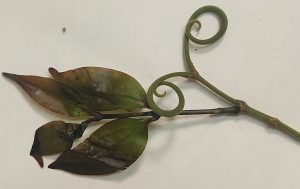
Strychnos lucens
Another widespread tropical African forest species was the climber, Strychnos lucens. This picture shows the paired tendrils characteristic of this species. It occurs in our Eastern Highlands forests.
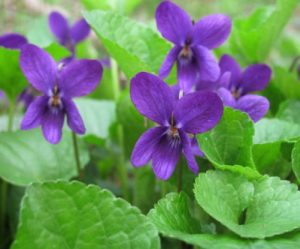
Viola odorata
On next to two violet-bushes from the genus Rinorea. Zimbabwe has 5 species in this genus, but we rarely see them as they are more or less confined to the E and SE of the country. They belong to the same family as violets, but these are usually small herbaceous plants with few obvious similarities. An example of a typical species of violet, Viola odorata Sweet violet is shown.
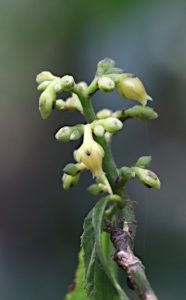
Rinorea ferruginea
The first Violet-bush, Rinorea ferruginea, the Hairy-leaved Violet-bush, has a terminal inflorescence, although it was not in flower at this time.
The second one was Rinorea convallarioides. This has lateral inflorescences and was flowering. The small flowers have tiny, reflexed lobes and the species is so named because the flowers resemble the unrelated Lily-of-the-valley, Convallaria majalis.
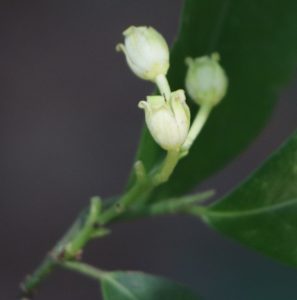
Rinorea convallarioides
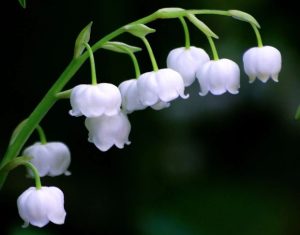
Convallaria majalis
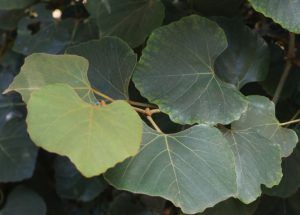
Rhoicissus tomentosa
A huge climber in the forest section was Rhoicissus tomentosa, the Common forest grape. This is the only one of our indigenous species of Rhoicissus which has simple leaves. The others are all compound with three leaflets. In Zimbabwe it is mostly to be found in the Eastern Districts, and it is also occasionally cultivated in Harare gardens.
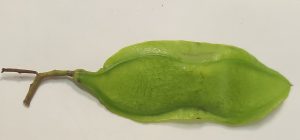
Xeroderris stuhlmannii – the wing-pod
As keen botanists, we did not confine our ramblings to the forest species.
We often examine the Xeroderris stuhlmannii, near the carpark and today was no exception as it was in fruit. These are very distinctive flat pods with fleshy wings.
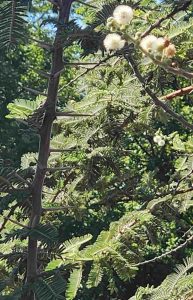
Vachellia rehmanniana
– Silky acacia
Not far from the Lake, was Vachellia rehmanniana, formerly Acacia rehmanniana, the Silky acacia. The features of this species were its fluffy, furry appearance with minute leaflets closely spaced, strong-coloured red bark and white bobble flowers.
There was some debate about whether members should retain Acacia or adopt Vachellia.
Despite the feeling that the name changes were made in a somewhat underhanded way, those attending felt they should conform to international standards and use the newer names. Acacia can be used with the common names.
In brief, species of Vachellia have straight thorns while the curved thorns belong to Senegalia.
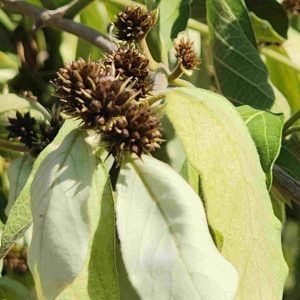
Combretum obovatum –
Spiny White-leaved Bushwillow
On the way to the forest section, the white leaves of Combretum obovatum, the Spiny White-leaved Bushwillow caught our eye. This is a very eye-catching species which is doing well in the Gardens.
The fruits were mostly 5-winged with one or two exceptions of 6 wings. The flowers are dark and are a contrast to the white leaves. This does not seem generally to be in the horticultural trade.
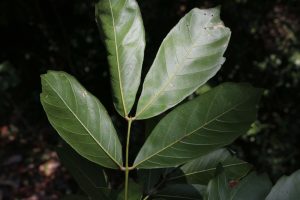
Blighia unijugata – Triangle tops
Blighia unijugata – Triangle tops is another rather local tree in Zimbabwe. The leaves (pictured) usually have 2 pairs of leaflets and no terminal leaflet.
The genus, Blighia, was named after William Bligh, who was an officer of the British Royal Navy and commander of the HMS Bounty – source: https://pza.sanbi.org/blighia-unijugata.
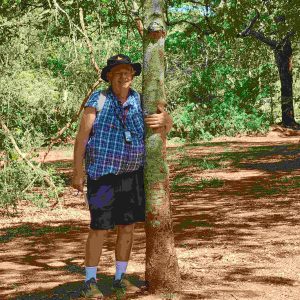
Mark clasps the trunk of one of the
Wooden bananas
Three specimens ofEntandrophragma caudatum– the Wooden Banana, have now been located in the Gardens. Thanks to Chris Chapano for the location of one of them.
No flowers have been seen on any of the three and none of them have been known to produce the famous fruit, but perhaps we just need to keep an eye on the trees.
Another recent discovery in the gardens was Cadaba kirkii, the Large-flowered Worm-bush. This is a Zambezi Valley species with intricate small yellow flowers and with a swelling at the apex of the petiole which is distinctive.
On first finding this shrub I thought it was Maerua angolensis, which has a similar petiole, but the flowers which fortunately were present showed it to be something quite different.
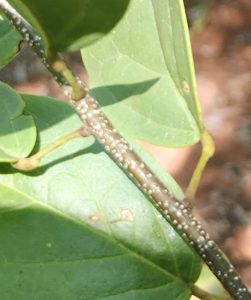
Cadaba kirkii with swelling at petiole apex
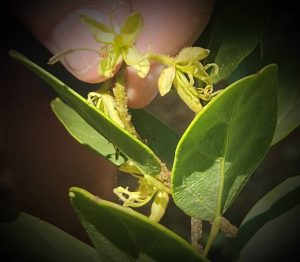
Flowers of Cadaba kirkii – the Large-flowered Worm-bush
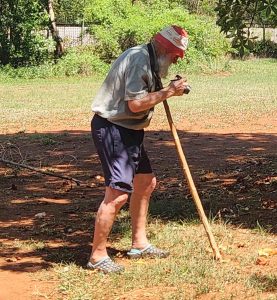
Jim Dryburgh, our chief photographer
Finally we came across a planted Baobab, Adansonia digitata. This was flowering but only small fruits were being formed and were dropping from the tree. Perhaps this was due to the exceptionally dry conditions of this season.
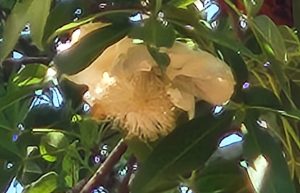
Baobab in flower
MAIN MEETING DECEMBER 2024:
We left members to explore and enjoy their surroundings on their own. Here are some of the pictures we received via WhatsApp.
Firstly from Dido in Bali, 3 stunning red species of Costus:

Costus sp. from Dido in Bali
An Acacia karroo in Piers Road from Barbara, an African spider lily, Lapeirousia odoratissima from Karl and tree planting in Strathaven from Kate:

Acacia karroo , an African spider lily, Lapeirousia odoratissima and tree planting in Strathaven
And a Christmas message came with these iconic Zimbabwean Christmas flowers from Karl:

Zimbabwean Christmas flowers
FROM THE WALRUS TO THE CARPENTER
The time has come, the Walrus said,
To talk of many things:
Of roots — and shoots — other stuff
Like Mycorrhizal fungi
On our tree walks with Cathy, she often gets excited about the Mycorrhizal fungi as she fossicks around stones or the roots of trees. So I decided to see if I could get further with my ideas about roots and trees. What do roots do? They anchor trees to the ground, absorb nutrients such as water, minerals and oxygen from the soil, as well as storing food and nutrients. A well-developed root system can also help prevent soil erosion.
 Are all roots basically the same?
Are all roots basically the same?
There are 3 basic types of tree roots as shown below, each with a different function.
- Tap root: provides stability and absorption but may be fairly short because deep soils lack the oxygen and nutrients that roots need and may vanish with the needs of a mature tree.
- Lateral roots: absorb a lot of water and nutrients as well as anchoring the tree.
- Root hairs: are where water and nutrients are directly absorbed but they are very fine and have a short life.
The root system is relatively inefficient, occupying less than 8% of underground space available for absorption of water and minerals. In addition, 80% of all roots occur in the top 12-36 inches of the soil.
To enhance efficiency, the tree has found an assistant organism, the mycorrhizal filaments from fungal spores. Firstly there are Rhizo bacteria which release phosphates from the soil and form a protective skin around the root keeping out harmful bacteria.
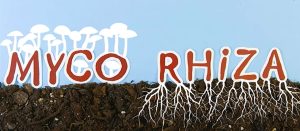
Myco = Latin fungus Rhiza = Greek roots
However, these bacteria cannot reach out from roots so do not increase the actual efficiency of the root system, for this the roots need their symbiotic relationship with Mycorrhizal fungi.
The mycorrhiza get nitrogen from the soil and transfer it to the roots and hence the tree. The tree photosynthesis sugars which it transfers via the roots to the mycorrhiza growth.
In many ways these fungi are similar to the trees themselves, they have:
- spores vs seeds
- mycelium (a root-like structure of a fungus ) vs a stem
- hyphae, a network of thin, thread-like strands that penetrate roots vs roots
- filaments, the secondary growth from hyphae vs root hairs
However, the hyphae spread through the root system and beyond increasing the efficiency of the local structure as well as extending the volume of soil which the tree can use to tap into for water and other nutrients.
So when trees are transplanted, many of the tree’s roots and the mycorrhizal fungi are left in the soil. To help it in its new location, keep as much of the original soil as possible with the roots, as well as the leaf growth. These help support the growth of new roots and increase the tree’s ability to become established.
But wait a bit,’ the Oysters cried,
Before we had this chat;
Some of us were quite confused
Now all of us are that!’
No problem!’ said the Carpenter.
They thanked him much for that.
FURTHER ISSUES FOR THIS OYSTER
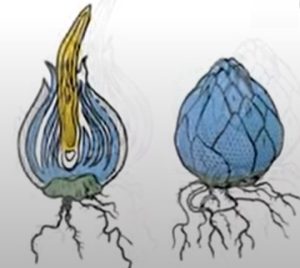
Bulbs
If mycorrhizal are fungi roots what is a rhizome? In fact, what is the difference between a root, a bulb, a rhizome, a corm and a tuber?
Starting with a bulb, this is easy – modified leaves, including scaly leaves, that are underground with roots growing from the basal plate.
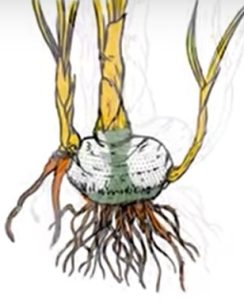
Corm
Now a corm is a modified stem but presents as a solid mass. They are generally oval but also with a basal plate for roots. They still however have the function of assisting the plant through a dormant period.
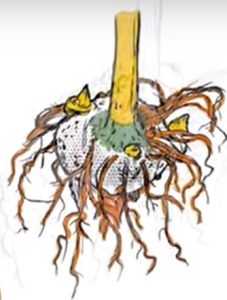
Stem tuber
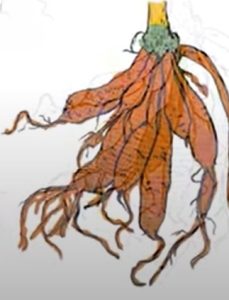
Root tuber
So what are tubers? Here things got complicated since there are root tubers (modified roots such as sweet potatoes) and stem tubers (modified stems such as normal white potatoes)! Stem tubers do not have a basal plate for roots but do regenerate through eyes on the skin of the tuber.
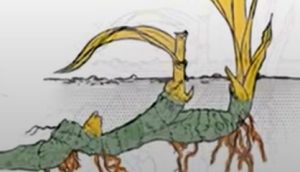
Rhizome
And finally, rhizomes, are a continuation of the main stem, generally underground and are therefore modified stems protected by scale leaves. Like some stems they have nodes, at which points a secondary stem and roots will grow.
I’m not much wiser but I now know:
Modified leaves – bulbs only
Modified roots – root tubers only
Modified stems – include corms, stem tubers and rhizomes, which are not in themselves roots!
ALSO ON SATURDAY 4TH JANUARY
For those members not walking in the botanical gardens, you are invited to help clear some of the invasive trees at the Greystone Nature Preserve :
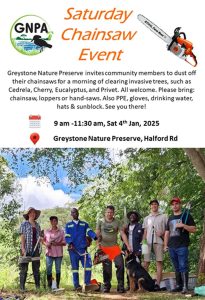
SOCIETY COMMITTEE AND CONTACTS
Chairman Tony Alegria tonyalegria47@gmail.com 0772 438 697
Vice Chairman Mark Hyde mahyde@gmail.com 0772 233 751
Honorary Treasurer Bill Clarke wrc@mweb.co.zw 0772 252 720
Secretary Teig Howson teig.howson@gmail.com 0772 256 364
Venue Organiser Ann Sinclair jimandannsincs@zol.co.zw 0772 433 125
Committee Member Jan van Bel jan_vanbel@yahoo.com 0772 440 287
Committee Member Ryan Truscott ryan.kerr.truscott@gmail.co 0772 354 144
Committee Member Sibusiso Malunga busimalunga@yahoo.com 0775 889 898
Tree Life Editor Linda Hyde Lmharwin@pentact.co.zw 0772 232 075
Tree Society Website https://treesociety.org.zw/
Tree Society Facebook https://www.facebook.com/groups/ztreesociety/
Flora of Zimbabwe: https://www.zimbabweflora.co.zw/
Flora of Tropical Africa: https://plants.jstor.org/collection/FLOTA


